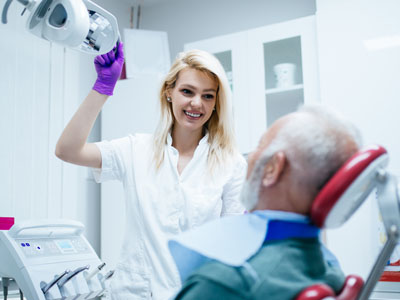Why oral cancer screening matters
Oral cancer screening is a routine but vital part of preventive dental care. Early detection dramatically improves treatment options and outcomes because precancerous changes and small lesions are easier to treat than advanced disease. A screening is not a diagnosis; it’s a focused check that helps identify suspicious areas that warrant closer evaluation or biopsy by a specialist.
Many people think of dental visits as opportunities for cleanings and cavities checks, but a thorough exam also assesses oral tissues for signs of abnormal cell changes. Because the mouth and throat are exposed to environmental and lifestyle risks, regular screenings provide an extra layer of protection and peace of mind for patients of all ages. Detecting problems early can reduce the need for more invasive interventions down the line.
Screenings are quick, noninvasive, and easily incorporated into standard dental exams. When clinicians make this a routine part of care, they create consistent opportunities to catch changes that may otherwise go unnoticed. For patients, that consistency translates into better long-term oral and overall health.
Understanding risk factors and who to monitor
Certain behaviors and medical histories increase the likelihood of developing oral cancer, so knowing your personal risk helps guide the frequency of screening. Tobacco use and regular heavy alcohol consumption remain two of the strongest risk factors. In recent years, human papillomavirus (HPV) infection has also emerged as a significant contributor, particularly for cancers of the oropharynx.
Age and sex play a role in risk assessment: historically, older adults and men have had higher incidence rates, but patterns are shifting and younger patients can be affected as well. Other contributing factors include prolonged sun exposure to the lips, a history of head and neck radiation, certain occupational exposures, and nutritional deficiencies that weaken tissue resilience.
Because risk varies from person to person, screening recommendations are individualized. Patients should discuss their lifestyle, medical history, and any family cancer history with their dental provider so the care team can determine an appropriate screening schedule and, when needed, arrange timely referrals.
What happens during a comprehensive screening
A standard oral cancer screening begins with a conversation. The dentist or hygienist will review your medical and dental histories and ask about any new symptoms, changes in swallowing, or lumps you might have noticed. This initial review helps the clinician focus the physical exam and identify any recent exposures or concerns that could be relevant.
The hands-on portion of the exam is straightforward and painless. It includes a careful visual inspection of the lips, tongue (including the underside), the floor of the mouth, gums, cheeks, hard and soft palate, and the back of the throat. The clinician will also palpate the tissues and feel the neck and jaw for any swollen lymph nodes or masses that could indicate a deeper issue.
In some practices, adjunctive tools are used to enhance visualization. These might include specialized lights or non-invasive screening devices that highlight abnormal tissue patterns. Such tools do not replace clinical judgment but can make subtle changes easier to spot. When anything unusual is found, the clinician documents its size, color, texture, and location and recommends appropriate next steps.
If an area appears suspicious, the care team will explain the findings, recommend additional diagnostic testing, and coordinate referrals when necessary. Tests might include an in-office brush biopsy, an imaging referral, or consultation with an oral surgeon or ENT (ear, nose, and throat) specialist to confirm the diagnosis and plan treatment.
Recognizing common signs and symptoms
Knowing what to watch for between dental visits empowers patients to act promptly. Persistent mouth sores, patches of red or white tissue, lumps or swellings that do not resolve within two weeks, and unexplained numbness are all reasons to seek a professional evaluation. Changes in voice, difficulty swallowing, or a persistent sore throat may also signal the need for a thorough exam.
Not all symptoms indicate cancer, but persistence and change over time are key warning signs. For example, an ulcer that heals and then reappears, or a small area that slowly increases in size, should be reassessed rather than ignored. Similarly, new or unexplained pain in the mouth or ear that does not follow a dental problem pattern deserves attention.
Because early lesions can be subtle, patients should report even small changes in texture, color, or sensation. The sooner an abnormality is evaluated, the sooner appropriate monitoring or intervention can begin. Open communication with your dental team ensures small concerns are addressed before they become larger problems.
Routine self-checks are a useful complement to professional screening: use a mirror and good lighting to look for unusual spots, bumps, or sores on your lips, cheeks, gums, and tongue. If you notice anything persistent or unfamiliar, bring it up at your next dental appointment or contact the office promptly for advice.
Prevention, early detection strategies, and follow-up care
Prevention and early detection work hand in hand. Reducing known risks—stopping tobacco use, limiting alcohol, practicing sun protection for the lips, and receiving recommended vaccinations such as HPV when appropriate—lowers overall risk. Regular dental visits that include targeted screenings are an essential part of a prevention-focused plan.
When a screening yields an abnormal finding, a clear follow-up plan is critical. The dental team will outline recommended monitoring intervals or next steps, which may include specialist referral, additional imaging, or biopsy. Coordination between dental and medical professionals ensures timely, multidisciplinary decision-making when needed.
Ongoing surveillance after treatment is equally important. Patients who have had precancerous lesions or treated oral cancers need regular clinical exams to monitor for recurrence or new areas of concern. Your dental provider will work with you and any other treating specialists to create a follow-up schedule tailored to your circumstances and risk profile.
At Cruzin' Dental, our approach combines careful examination with clear communication so patients understand what to expect and why follow-up matters. If you have questions about oral cancer screening or are due for an exam, please contact the practice for more information. We’re here to help you stay proactive about your oral health.




